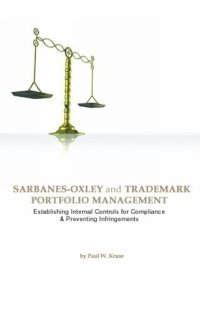Book DescriptionThe Sarbanes-Oxley Act of 2002 was signed into law on July 30, 2002. Although vastly complex, the legislation has a fairly simple aim, namely, to reform a number of business and accounting practices that significantly distorted the economic performance of Enron and WorldCom to the detriment of their investors. Corporate America is now spending millions of dollars complying with the requirements of Sarbanes-Oxley.
The prevention of consumer confusion as to either source of origin or sponsorship has historically been viewed as trademarks" primary raison d"être. However, trademarks afford their owners far more than just the legal right stop newcomers from using similar marks in ways that are likely to cause confusion. Competitors constantly challenge customer loyalty and trademarks are often the only way to effectively meet this challenge. No longer seen simply as a legal right to exclude newcomers, trademarks are increasingly viewed as valuable intangible assets. Like fixedassets such as buildings and equipment, trademarks must be managed, protected, valued and reported in financial statements.
Sarbanes-Oxley does not specifically mention trademarks (or any other intellectual property for that matter). However, if thetrademarks of companies subject to the reporting requirements of the Securities and Exchange Commission are material assets, internal controls should be in place to assure that the risks inherent in the use and registration of the trademarks are effectively managed and reported.
Although the restoration of investor confidence in corporate reporting and accountability is clearly a worthwhile goal, the return-on-investment in complying with Sarbanes-Oxley is often hard to see. However, Sarbanes-Oxley and Trademark Portfolio Management makes the return-on-investment in a well managed and maintained trademark portfolio plain to see.Download DescriptionThe Sarbanes-Oxley Act of 2002 was signed into law on July 30, 2002. Although vastly complex, the legislation has a fairly simple aim, namely, to reform a number of business and accounting practices that significantly distorted the economic performance of Enron and WorldCom to the detriment of their investors. Corporate America is now spending millionsof dollars complying with the requirements of Sarbanes-Oxley. I toyed with titling this book "CEOs and CFOs, It"s Time To Certify The Annual Report, Do You Know Where Your Trademarks Are?" If a company subject to Sarbanes-Oxley is not certain as to the trademarks it owns, what those trademarks are worth or whether or not any of them infringe or are being infringed upon, then Section 404 requires that internal controls be created or improved. If the CEO and CFO of such a company are not aware of these aspects of their trademarks, they cannot certify, under Section 302, that annual reports present a fair and accurate picture of the company. Finally, if the CEO and CFO of such a company do not know all the facts about their trademarks and, further, do not know whether or not internal controls and reporting are adequate and accurate, they cannot certify, under Section 906, that financial statements are indeed accurate. However, as more fully explained herein, a well managed and maintained trademark portfolio makes it easy for the CEO and CFO to "know where their trademarks are" at all times. Sarbanes-Oxley and Trademark Portfolio Management shows that although the restoration of investor confidence in corporate reporting and accountability is clearly a worthwhile goal, the return-on-investment in complying with Sarbanes-Oxley is often hard to see. About the Author: For over the last decade, Paul Kruse has practiced primarily trademark law. Currently a partner at Bass, Berry & Sims in Nashville,Tennessee, Mr. Kruse is a member of the corporate group. Prior to joining the firm, he was a partner at Pillsbury Winthrop in Washington, D.C. Prior to that he was a Trademark Attorney - Advisor at the U. S. Patent and Trademark Office, where he examined over 4400 trademark applications for compliance with the Lanham Act, the Trademark Rules of Procedure and the Trademark Manual of Examining Procedure. Это и многое другое вы найдете в книге Sarbanes-Oxley and Trademark Portfolio Management: Establishing Internal Controls for Compliance & Preventing Infringement (Paul Kruse)
